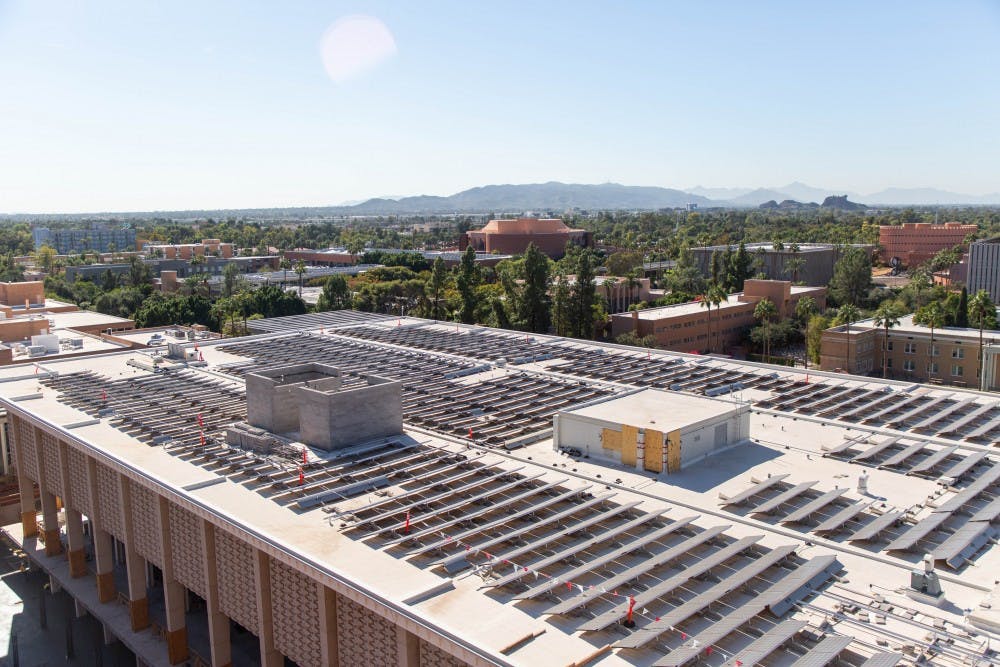On Tuesday, ASU hosted a webinar to promote a new book titled "Cities of Light: A Collection of Solar Futures" and to discuss the future economic and social justice implications of a fully sustainable society.
The book is a sequel to “The Weight of Light: A Collection of Solar Futures”, and is a collaboration between ASU’s Center for Energy and Society and Center for Science and the Imagination and the U.S. National Renewable Energy Laboratory.
According to its Center for Science and the Imagination page, Cities of Light consists of “A collection of science fiction stories, art and essays exploring how the transition to solar energy will transform cities; catalyze revolutions in politics, governance, and culture; and create diverse futures for human communities.”
The webinar’s panel comprised contributors to the book, including S.B. Divya, Patricia Romero-Lankao, Yíamar Rivera-Matos, Angel L. Echevarria, Joey Eschrich and Clark A. Miller.
The two short stories the panel spoke about were called “Things That Bend But Don’t Break” and “Solar Shades." The short stories and complementing essays take place in San Juan, Puerto Rico.
The stories draw from the backgrounds of some contributors of the book, like Echevarria and Rivera-Matos. Both grew up in Puerto Rico and used their personal experiences to help craft the book.
Both stories are science-fiction, as they explore the futuristic possibilities of what sustainable, renewable energy can be.
Cities have choices when it comes to renewable energy
Miller, director of ASU’s Center for Energy and Society, said cities are the centerpiece of the problems facing climate change.
“They are where most of humanity now lives and where the most energy is consumed ... so solving that energy challenge for cities is a fundamental piece of the puzzle,” Miller said.
He said cities are already taking many different approaches to creating sustainability. Miller used Minneapolis as an example of a city encouraging community-scale solar development within its neighborhoods. Other cities have persuaded commercial operations to put solar panels on their rooftops, and some cities are even installing large-scale solar farms.
“These are obviously not choices that are going to be (easy) ... they are choices that result from fights over how we design the energy systems and their social relationships of the future,” Miller said. "And at the same time, (the book) opens up the imagination of those in positions of power to recognize that there isn't just one answer as to what tech should look like in the future and that they should take all of the possibilities seriously.”
Romero-Lankao, a senior research scientist for the National Renewable Energy Laboratory's Center for Integrated Mobility Sciences, said she believes the global transition to zero carbon emissions is just as constrained by social justice and inequality as it is by technological or physical limits.
“There are already calls to consider equity and justice in these transitions, but we don't really know a lot about how to make sure that this new technology, such as solar, is accessible and utilized by minority and working-class people,” Romero-Lankao said.
Narratives are power
A recurring subject throughout the conversation was the power of public perception, and how those narratives can shape popular culture and everyday social encounters.
“The ability to articulate a narrative is key in the success powerful groups have to define what the future of the world is ... but we can also use the power of narrative and images to articulate alternative options and views of what the problems and solutions are,” Romero-Lankao said.
Divya commented on the difficulty of transforming point of views through narrative storytelling.
“Seeing is believing. There are practical challenges of moving from fictional narratives to immediate social change because you can't break down social power structures with good storytelling,” Divya said.
She said the collective consciousness of society, when repeatedly given the same story elements, can not only shape how society thinks and what it believes is possible, but can also influence what it values morally, ethically and socially.
Divya used an example of how prior to the election of former President Barack Obama, Hollywood would sometimes use the narrative of a powerful Black president in TV or movies, such as Morgan Freeman or Dennis Haysbert. She believes these storytelling decisions may have led to “an unconscious collective acceptance (from society) that this type of situation will be fine.”
Miller said he and Eschrich believe that the “second stage” of the book is to use these stories to foster conversations about what types of renewable energies are possible in the future.
Reach the reporter at jspange1@asu.edu and follow @jspangenthal94 on Twitter.
Like The State Press on Facebook and follow @statepress on Twitter.
Continue supporting student journalism and donate to The State Press today.

Justin Spangenthal is a reporter for The State Press, currently covering Men's Golf and Track and Field. Justin transferred to ASU last January and is planning to graduate Fall '23. He is passionate about journalism and hopes to one day launch his own media outlet.




